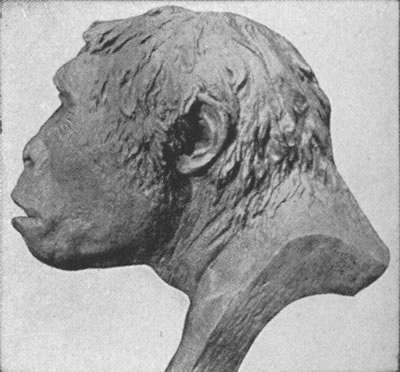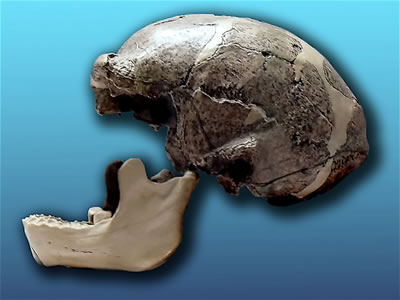Homo erectus was the first relative of modern human beings to live outside of Africa, to use complex tools, to hunt in organized groups and to use fire.
The name Homo erectus means "upright human."
When Homo erectus was alive, between half a million and two million years ago, Africa's climate was changing dramatically. Lakes were shrinking and rivers were drying up. Open grasslands and savannahs replaced forests and woodlands
Most scientists think that Homo erectus emigrated from Africa about one million years ago.
Some paleoanthropologists say that the early populations of these hominids, which lived in Africa, were in fact a different species, nown as Homo ergaster ("working human"). Homo erectus consisted only of the later populations, which lived in Africa, Asia and Europe. Others say that Homo ergaster and Homo erectus were the same species.
Some paleoanthropologists believe that the European population made up a third species: Homo heidelbergensis, which was named for the University of Heidelberg in Germany.
Homo ergaster is believed to be an ancestor of modern humans (Homo sapiens).
Others say that all of these early humans belonged to the species Homo erectus.
Characteristics
Homo erectus had a brain that was larger than that of Homo habilis, but generally smaller than that of modern humans. The largest brains of Homo erectus were the same size as those of modern humans, but with a different configuration.
While Homo habilis had a large, backward sloping forehead, Homo erectus had a large, bony brow ridge that extended past its eyes.
Homo erectus had a flatter skull than Homo habilis
It had a profile that was a closer to that of a modern human,
The nose of Homo erectus was similar to that of a human being alive today. It protruded from the face, and had nostrils that pointed downward. This would help it to breathe warm, dry air.
Homo erectus was taller than Homo habilis - the same size as a modern human.
However, it was more robust and muscular than a modern human.
Homo erectus had shorter arms than Homo habilis. Its limbs were closer in proportion to those of Homo sapiens.
Males were about 25% larger than females. In earlier hominids, males were almost twice as large as females.
The pelvic area was narrow, so babies would have been very immature when they were born, in comparison to the newborns of earlier humans. The brain of an adult Homo erectus would be about three times the size of a newborn, while the brain of an adult non-human ape is about twice the size of a newborn.
 Discoveries
Discoveries
In 1891, Eugene Dubois discovered a hominid skullcap in Java. His find became known as Java Man.
Between 1929 and 1937, many fossils of early humans were discovered in Zhoukoudien Cave near Beijing (formerly Peking) in China.
The species they were believed to represent became known as Peking Man.
 Both Java Man and Peking Man are now thought to be examples of Homo erectus.
Both Java Man and Peking Man are now thought to be examples of Homo erectus.
In 1984, Louis Leakey found the skeleton of an 8 to 12 year old Homo erectus or Homo ergaster boy at Nariokotome, near Lake Turkana in Kenya. It was one of the most complete skeletons of an early human ever discovered.
The boy, who died about one and a half million years ago, became known as Turkana Boy or Nariokotome Boy.
He was 5 feet 3 inches tall when he died. If he had lived to be an adult, he may have reached 6 feet.
His body was robust, and well adapted for walking long distances in a hot, dry climate.
Other remains indicating the presence of Homo erectus - both fossil remains and the remains of stone tools - have been found in Africa, Asia and Europe.
Tools
The tools used by Homo erectus were more advanced than those that were used by Homo habilis. While Homo habilis used simple flakes, Homo erectus used more complex flakes, which could be used for cutting, pounding, chopping and piercing.
The most common tools used by Homo erectus were the hand axe and the cleaver. The hand axe is a pointed tool that can be completely surrounded with a cutting edge. The cleaver is a flake with a sharp, straight edge.
The tools that were used by Homo erectus are known as Acheulean tools, after St Acheul in France, one of the sites where they have been found.
Hunting
While Homo habilis was probably a scavenger, who used tools for picking meat off bones or retrieving marrow from bones, Homo erectus took part in organized, cooperative hunting.
The remains of large groups of animals, such as antelopes and baboons, have been found next to hand axes that would have been made by Homo erectus.
The social life of Homo erectus was probably similar to that of human hunter-gatherers who are alive today. Homo erectus probably lived in small bands.
Fire
Sites in Asia and Europe indicate that Homo erectus was able to control fire as far back as one and a half million years ago.